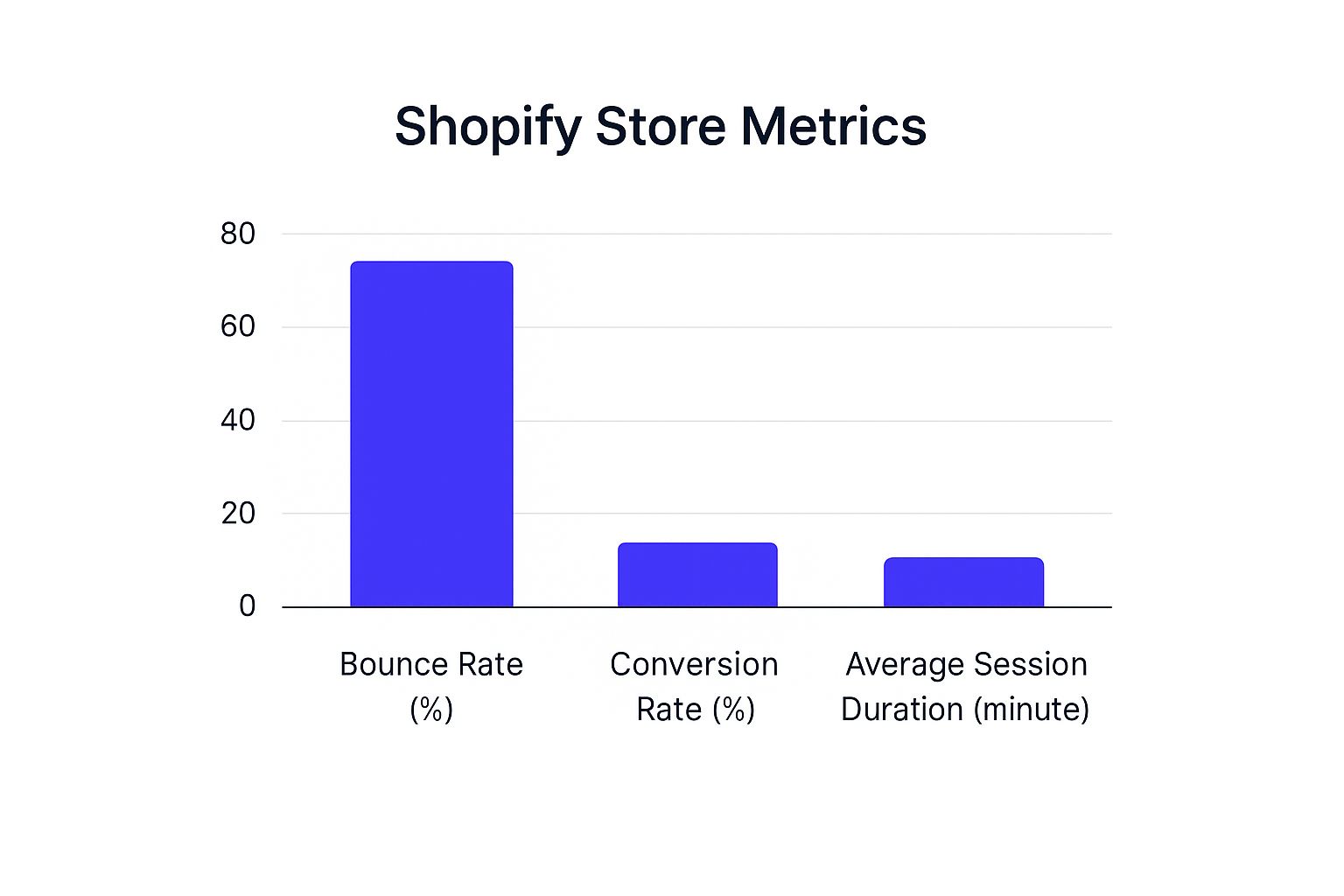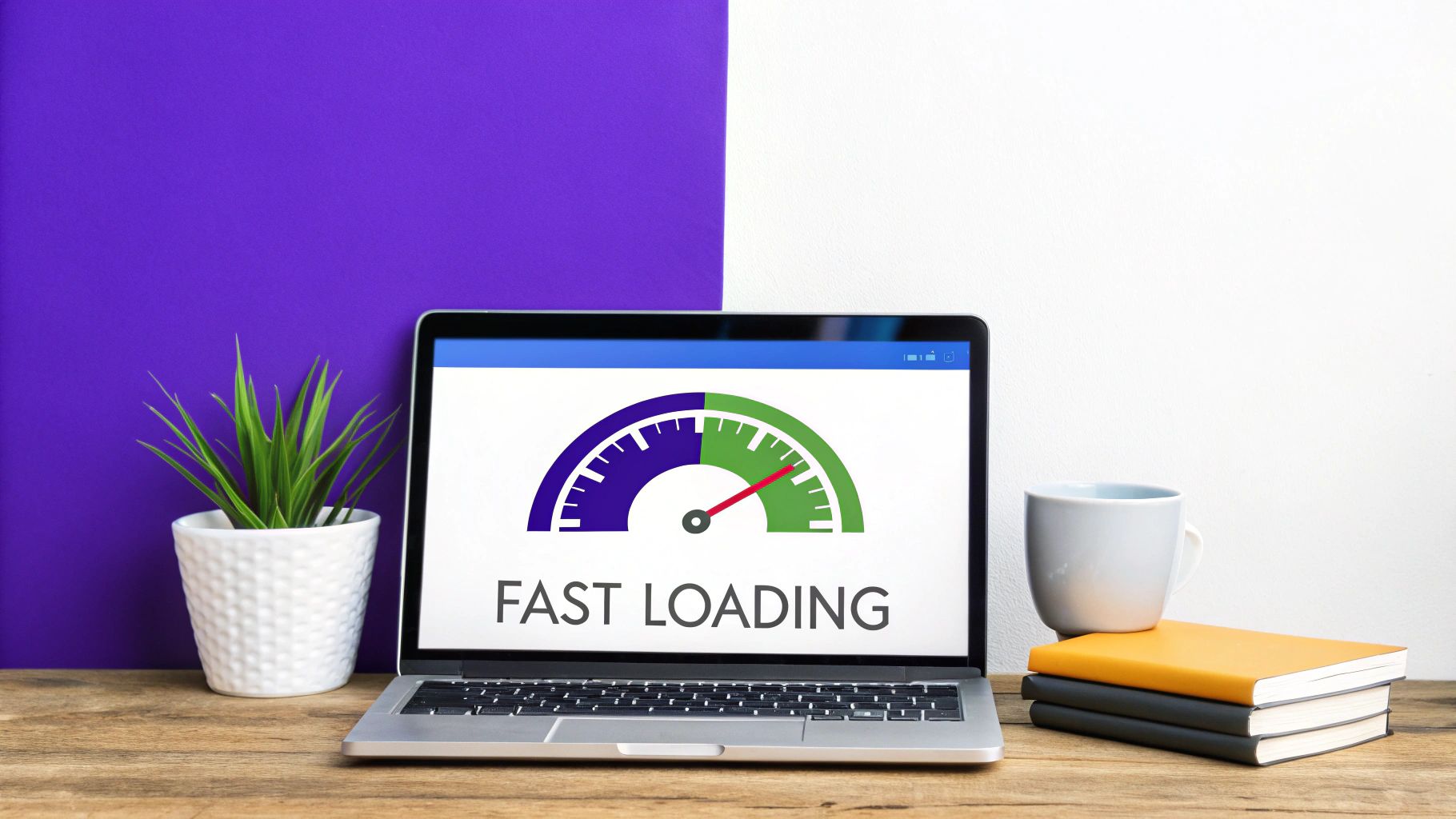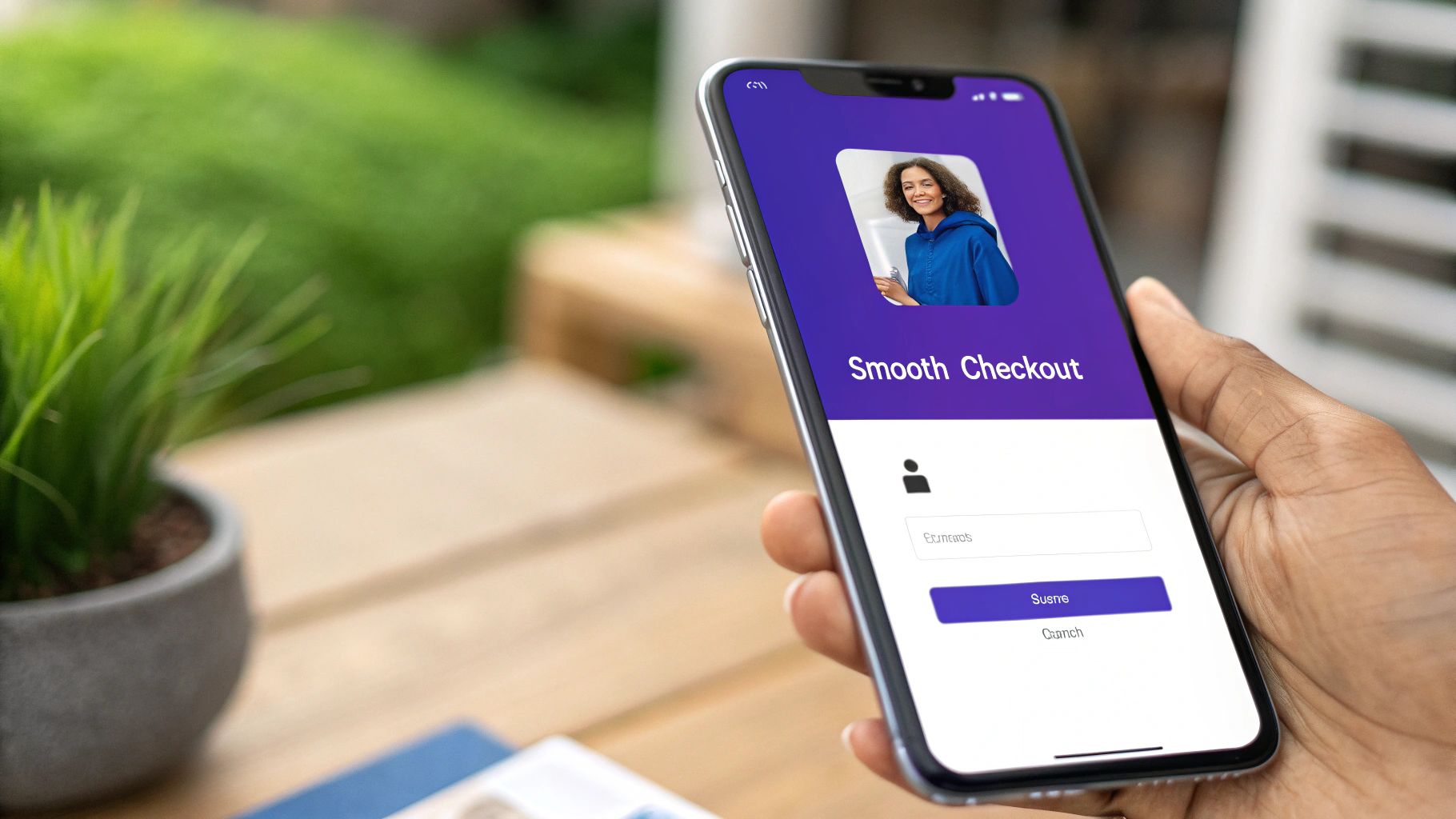Understanding Where Your Store Actually Stands
Figuring out how well your Shopify store is performing can be tough. Many merchants compare their stores to outdated data or unrealistic averages. This can lead to a skewed understanding of what "good" performance actually looks like. Your "good" conversion rate might actually be underperforming, or your "low" rate could be exceeding industry expectations.
Defining Your Baseline
A crucial first step in Shopify conversion optimization is setting a realistic baseline. This means understanding the average conversion rates for your specific industry and product category. For example, a store selling high-end jewelry will likely have a different conversion rate than a store selling everyday household items. Factors like price point, customer demographics, and purchasing considerations contribute to this difference. Knowing these nuances helps you set achievable goals and tailor your optimization strategies.
Consider the impact of your traffic sources, too. Traffic from paid advertising might convert at a higher rate than organic traffic. This is because those visitors are often actively searching for products similar to yours. However, neglecting organic traffic can stifle your long-term growth. A balanced approach to traffic acquisition is key for sustainable Shopify conversion optimization.
Shopify’s average conversion rate offers valuable insight into the state of online retail. The current global average Shopify conversion rate hovers around 1.4%. This means for every 100 visitors, roughly 1.4 make a purchase. This highlights the competitive ecommerce landscape.
Many store owners struggle to convert browsers into buyers, especially when compared to broader industry averages. The general ecommerce sector sees average conversion rates between 2.5% and 3%. This lower average for Shopify suggests many users are still refining their conversion funnels. Even so, Shopify's conversion rate still outperforms other platforms – by 15% or more in many cases, and up to 36% against certain competitors. For a more detailed analysis, check out these stats: Learn more about Shopify Conversion Rates.
Identifying Hidden Factors
Beyond benchmarks and traffic, several hidden factors influence conversion rates. Seasonal variations can drastically impact sales. A swimwear store will likely see higher conversions in the summer than the winter. Similarly, promotional campaigns and discounts can create temporary spikes in conversion rates. For a detailed guide, check out these conversion optimization tips to improve your website today.
Moving Beyond Vanity Metrics
While your overall conversion rate is a valuable metric, focusing only on this number can be misleading. Instead, analyze micro-conversions. These are smaller actions that contribute to the overall sales funnel:
- Adding a product to the cart
- Creating an account
- Signing up for your email list
Tracking micro-conversions offers a detailed view of customer behavior. This helps identify areas for improvement within your store, like pinpointing where customers abandon their carts. From there, you can implement strategies to nudge them toward purchasing. This approach helps you move beyond surface-level metrics and focus on the actions that truly drive sales.
Secrets From Stores Converting At Triple The Average
What separates the top Shopify stores from the pack? It's not luck, but a dedication to Shopify conversion optimization. These high-performing businesses treat optimization as a continuous process. They test, refine, and adapt, often going against conventional wisdom to achieve remarkable results.
Unlocking The Power Of Counterintuitive Strategies
Top Shopify stores understand that boosting conversions isn't about following a rulebook. Instead, they focus on truly knowing their customers and creating a tailored shopping experience. Some successful stores, for example, actually introduce friction points, like requiring account creation before checkout. This may seem counterintuitive, but it can build stronger customer relationships and enable more personalized marketing, ultimately increasing customer lifetime value.
Product descriptions are another area where top stores break the mold. They go beyond listing features, instead weaving compelling stories around their products. This emotional connection increases the perceived value and fuels customer desire.

The infographic above illustrates the relationship between Bounce Rate, Conversion Rate, and Average Session Duration for a sample of Shopify stores. A lower bounce rate, combined with a higher conversion rate and longer session duration, indicates the importance of a seamless and engaging shopping experience.
Case Studies: Turning Mediocre Into Exceptional
Real-world examples are key to understanding effective Shopify conversion optimization. One Shopify merchant selling handcrafted leather goods significantly boosted conversions with personalized product recommendations. They analyzed customer data to suggest complementary items, which increased average order value.
Another store selling organic skincare products saw a conversion rate jump after adding a live chat feature. This allowed them to address customer questions immediately, building trust and reducing purchase hesitation.
Immediate Impact Vs. Long-Term Gains
Some optimizations, like A/B testing headlines or button colors, deliver quick wins. Others, like building a loyal customer base through email marketing or content marketing, require a longer-term strategy. The best Shopify stores understand this, balancing short-term wins with strategies for sustained growth.
The top 10% of Shopify stores boast an average conversion rate of 4.7%, more than triple the platform average. This underscores the significant impact of effective optimization. This translates to nearly 5 sales for every 100 visitors. Find more detailed statistics here.
To better understand the strategies behind these impressive numbers, let's examine the different performance tiers. The following table breaks down conversion rate ranges and the key optimization strategies for each tier:
Shopify Store Performance Tiers and Characteristics
| Performance Tier | Conversion Rate Range | Key Characteristics | Primary Focus Areas |
|---|---|---|---|
| Top Performers (Top 10%) | 4.7% and above | Highly personalized experiences, strong brand loyalty, advanced data analysis, proactive customer support | Continuous optimization, customer retention, expanding into new markets |
| Average Performers | 1-2% | Basic optimization strategies implemented, decent brand awareness, some customer loyalty | Improving user experience, refining marketing strategies, increasing customer lifetime value |
| Underperformers | Below 1% | Lack of clear optimization strategy, weak brand identity, poor customer experience | Implementing foundational optimization strategies, building brand awareness, improving customer service |
This table highlights how crucial strategic optimization is for achieving high conversion rates. The top performers demonstrate a dedication to personalized experiences and data-driven decision-making.
Maintaining The Competitive Edge
The world of ecommerce is constantly changing. Successful stores understand they need to stay ahead of the curve. They consistently analyze data, experiment with new strategies, and adapt to market trends. This ongoing commitment to Shopify conversion optimization is what keeps them competitive.
Beyond optimization, they focus on building a strong brand identity and nurturing a loyal customer community, driving long-term growth and ensuring sustainable success.
Fixing The Checkout Experience That's Killing Your Sales
Your checkout process is the final hurdle in ecommerce. You might attract tons of traffic to your Shopify store, but a cumbersome checkout experience guarantees lost revenue. It's often the biggest source of lost sales. This section explores key aspects of Shopify conversion optimization, focusing specifically on the checkout.

Identifying Friction Points in Your Checkout
Many store owners mistakenly think a complicated checkout demonstrates thoroughness. In reality, complexity often leads to fewer sales. Every extra step, confusing field, or unexpected delay creates friction. This increases the chance of customers abandoning their carts. Think of a physical store with a long, confusing checkout line and a single cashier. This mirrors a poorly designed online checkout.
To optimize your checkout, pinpoint these friction points. Analyze the checkout flow from the customer's viewpoint. Too many required fields? Unclear navigation? Hidden shipping costs? Answering these questions reveals areas for improvement. The goal: a smooth, effortless purchase experience.
Psychological Triggers and Checkout Optimization
Understanding online shopper psychology is crucial. Customers want to feel secure when entering payment details. Displaying security badges and using secure payment gateways builds trust. Offering multiple payment options also reduces friction, as customers may abandon their carts if their preferred method isn't available.
When selling courses through Tevello, ensuring a seamless checkout experience is especially critical. With Tevello’s deep Shopify integration, digital course sales benefit from Shopify’s secure payment gateways and optimized checkout flow, helping reduce friction and maximize conversion rates.
Form anxiety also plays a role. Long forms can overwhelm customers. Simplify forms by requesting only essential information. Auto-filling fields streamlines the process. Small design choices, like clear buttons and progress indicators, subtly encourage completion. Shopify checkout conversion rates reveal common ecommerce pitfalls. The typical Shopify store’s conversion rate is 1.5% to 2.5%, with less optimized stores falling in the 1-2% range. This highlights the importance of a frictionless checkout. Find more detailed statistics here.
Implementing and Testing Checkout Optimizations
After identifying potential improvements, it's time for implementation and testing. A/B testing compares different checkout versions. By testing individual changes, you isolate their impact and find the most effective strategies.
Here are some actionable checkout optimizations:
- Streamlined Form Design: Minimize required fields.
- Guest Checkout Option: Let customers checkout without creating accounts.
- Clear Progress Indicators: Show checkout progress.
- Multiple Payment Options: Offer various payment methods.
- Prominent Security Badges: Display trust badges.
Check out our guide on How to Increase Shopify Sales for more proven tips. For further checkout flow improvements, see this Checkout guide. Continuously testing and refining your checkout significantly reduces cart abandonment and boosts your Shopify conversion rate.
Apps And Tools That Actually Move The Needle

The Shopify app store offers a huge range of apps. But finding the perfect ones for Shopify conversion optimization can be tough. Many store owners install too many, which can slow down their websites and hurt conversions. This section will help you choose and use apps that make a real difference.
One standout app is Tevello. It empowers course creators and educators to integrate digital courses directly into their Shopify stores, manage enrollments, and build engaged communities, all while optimizing for sales and conversions.
Separating Game-Changers From Overhyped Solutions
Not every app is valuable. Some genuinely help, while others only seem helpful. The key is to choose apps that fix specific problems in your sales funnel.
For example, if shoppers abandon their carts often, think about using exit-intent pop-ups with discounts. Or, consider apps that recover abandoned carts by sending targeted emails.
Essential Apps Vs. Conversion Killers
Some apps might seem essential, but they can slow down your site and create a bad user experience. A slow site usually means more people leaving without buying anything.
Before installing any app, check how it affects your site speed. Use tools like Google’s PageSpeed Insights to measure load times.
Strategic App Selection and Implementation
Choosing apps strategically is crucial for successful Shopify conversion optimization. This means focusing on apps that match your business goals.
- Identify Your Bottlenecks: Where are customers leaving your sales process? Are they abandoning their carts, or not adding items at all?
- Prioritize Solutions: Choose apps that directly fix these problems.
- Test and Measure: After installing an app, track its effect on important metrics. These include conversion rates, bounce rates, and average order value.
To help you get started, here’s a table highlighting some useful apps:
To help you select the right apps for your store, we've compiled a comparison of top Shopify conversion optimization apps based on category. This table will help you understand the key features and pricing of essential apps for optimizing different aspects of your store.
Top Shopify Conversion Optimization Apps by Category
| App Category | Top Recommended Apps | Key Features | Pricing Range | Best For |
|---|---|---|---|---|
| Email Marketing & Abandoned Cart Recovery | Klaviyo, Omnisend, Privy | Automated email flows, segmentation, pop-ups | Varies, often tiered based on features and contacts | Re-engaging customers, reducing cart abandonment |
| Reviews & Social Proof | Yotpo, Loox, Judge.me | Product reviews, customer testimonials, social media integration | Varies, often freemium models with paid upgrades | Building trust, increasing purchase confidence |
| Upselling & Cross-selling | Rebuy, Bold Upsell, CartHook | Personalized product recommendations, post-purchase offers | Varies, often based on usage or sales generated | Increasing average order value |
| Site Speed Optimization | NitroPack, PageFly, Plug in SEO | Image optimization, code minification, caching | Varies, often tiered based on features and page views | Improving site performance, reducing bounce rates |
This table provides a good starting point. Research each app carefully and select the ones that best fit your needs and budget. This strategic approach ensures you're using tools that truly improve your Shopify conversion rate. For further guidance, check out resources and guides focused on Shopify Conversion Optimization Strategies. By combining the right apps with a strong optimization strategy, you’ll be well on your way to seeing real improvements.
Product Pages That Sell While You Sleep
For course creators using Tevello, your product pages can double as your course sales pages, with integrated enrollments and a seamless checkout experience. This ensures students can purchase and access their learning materials effortlessly.
Your product pages are constantly accessible online, but are they effectively turning visitors into paying customers? Many Shopify merchants treat product pages like simple online catalogs rather than persuasive sales tools. This is a significant missed opportunity for increasing your Shopify conversion rate. Let's explore how to make your product pages work harder for you, generating sales around the clock.
Psychology of Persuasion on Product Pages
Understanding the motivations of online shoppers is key to optimizing conversions on Shopify. High-converting product pages go beyond just features. They tap into the psychology behind buying decisions. For instance, highlighting limited availability creates a sense of urgency, encouraging immediate purchases.
Clearly explaining the benefits of your products, rather than just their technical specifications, connects more effectively with potential customers. Show how your product solves a problem or improves their lives, not just its technical details.
Social Proof Without Being Pushy
Social proof, like customer testimonials, is a powerful tool. But it needs to be used strategically. Too many testimonials can seem fake, and negative reviews can hurt your brand's credibility. Instead of overwhelming visitors, showcase a curated collection of positive testimonials that spotlight key product benefits. Authentic user-generated content, like customer photos, can significantly boost trust and drive sales.
Mobile Optimization Beyond Responsive Design
While a responsive design is essential, true mobile optimization means understanding how mobile shoppers behave. Mobile users tend to scan content quickly and are less tolerant of slow loading times. Therefore, prioritize concise product descriptions, clear calls to action, and streamlined navigation tailored for mobile devices. Large, easy-to-tap buttons and simplified forms are essential for improving mobile conversion rates. Learn more in our article about How to sell digital products on Shopify.
Crafting Compelling Product Descriptions
Your product descriptions are your opportunity to tell a story. Instead of dryly listing specifications, focus on the advantages your product provides. Use engaging language to paint a picture of how the product will improve the customer's experience. Address potential concerns proactively. For example, if durability is important, emphasize it in your description. This builds trust and reduces hesitation to buy.
Testing for Continuous Improvement
Like all aspects of Shopify conversion optimization, product page improvement is an ongoing effort. Regularly A/B test different elements, like headlines, images, and calls to action. This helps you understand what resonates with your audience and continually refine your strategies. By tracking add-to-cart rates and conversion rates, you can identify what's working and what needs adjustment.
For course creators using Tevello, product pages double as course sales pages, making it even more crucial to test features like course descriptions, video teasers, and enrollment CTAs. Tevello’s seamless Shopify integration ensures these changes can be implemented easily, providing a smooth experience for both you and your students.
By implementing these strategies, you can transform your Shopify product pages into effective conversion machines that constantly generate sales, even when you're not working. This proactive approach gives every visitor the best experience, maximizing your chances of turning them into loyal customers.

Testing Your Way To Consistent Growth
Optimizing your Shopify store without a clear strategy can feel like wandering in the dark. You might make changes, but are they truly effective? True Shopify conversion optimization requires a systematic approach, using data-driven testing to reveal real insights. This section explores proven testing methodologies and real-world examples to help boost your conversion rate.
Designing Tests That Matter
Effective testing begins with a clear objective. Identify specific areas needing improvement, such as a high cart abandonment rate or a low click-through rate on product pages.
Next, formulate a hypothesis about changes that could boost these metrics. For example, you might hypothesize that "Simplifying the checkout process will decrease cart abandonment."
Once you have a hypothesis, design a test to validate it. A/B testing, a common method, involves creating two versions of a page: a control (version A) and a variant with your proposed change (version B). Direct traffic to both and track performance differences.
Avoiding Common Testing Mistakes
Several pitfalls can skew test results. Testing too many changes at once makes it difficult to isolate the impact of each change. Another common error is ending tests prematurely. Ensure your tests run long enough to gather statistically significant data.
Building a Culture of Continuous Improvement
Shopify conversion optimization is an ongoing process, not a one-time fix. Cultivate a culture of continuous improvement within your team. Regularly review data, identify new testing opportunities, and implement data-backed changes. This iterative process, over time, leads to sustained growth.
Interpreting Results With Limited Traffic
Even with limited traffic, you can still gain valuable insights. Focus on testing high-impact areas, such as your checkout process and product pages. Prioritize changes likely to have the most significant effect on conversions.
Implementing Changes That Maintain Momentum
When implementing changes based on test results, consider the overall impact on your store. Avoid disrupting successful elements for marginal gains. For example, if a redesign improves product page conversions, ensure it aligns with your brand and doesn't negatively impact other metrics like site speed.
Advanced Analytics For Deeper Insights
Shopify's built-in analytics offer valuable data on customer behavior. Third-party tools, such as heatmaps from Hotjar, can provide a deeper understanding of visitor interactions, helping you pinpoint areas for improvement and understand customer behavior patterns.
Practical Templates and Frameworks
To streamline your testing process, utilize templates and frameworks for several key areas:
- Hypothesis Formation: Clearly define the problem and your proposed solution.
- Test Documentation: Record all test details, including changes, tracked metrics, and observed results.
- Results Interpretation: Analyze the data and draw actionable conclusions.
By adopting a systematic approach, you can transform Shopify conversion optimization into a predictable growth engine. This focused strategy helps you avoid wasting time and concentrate on proven methods to increase sales. For more actionable steps towards improved customer retention, see our guide: 10 Ecommerce Customer Retention Strategies to Boost Sales.
Your Conversion Optimization Action Plan
Knowledge without action is useless. Taking random actions without a clear strategy can be detrimental. This action plan provides a practical roadmap for Shopify conversion optimization, tailored to your specific needs and available resources.
Prioritizing Your Optimization Efforts
Not all optimizations are equally effective. Some offer quick wins, while others demand more time and investment. Prioritize your efforts based on your current performance, budget, and overall business goals.
-
Low-Hanging Fruit: If your conversion rate is significantly below the industry average, focus on fundamental improvements. These might include streamlining the checkout process or enhancing the clarity of your product pages.
-
Strategic Investments: If your store is already performing well, you can explore more complex strategies. Consider personalization tactics or implementing a customer loyalty program. This allows you to build on your existing success and reach new heights.
Don’t forget: if you’re selling courses, Tevello offers a ready-made solution to boost conversions by seamlessly integrating your course offerings into your Shopify store. Learn more about how Tevello can help you turn browsers into enrolled students.
Setting Realistic Timelines and Expectations
Shopify conversion optimization isn't a quick fix. It requires time and consistent effort to see meaningful results. Avoid expecting immediate changes. Instead, establish realistic goals and monitor your progress.
For instance, if you're using A/B testing on your product pages, a reasonable target might be a 5-10% lift in conversions within the first three months. As you collect more data and refine your strategies, you can adapt these objectives.
Maintaining Momentum During Testing Failures
Not every optimization attempt will be a winner. Many tests will fall short of expectations. This is a normal part of the optimization journey. The important thing is to extract valuable lessons from these setbacks. Use those insights to inform your next round of testing.
Treat optimization as a scientific experiment. Every failure brings you closer to understanding what truly resonates with your store and customers. Persistence is key to achieving long-term success.
Scaling Successful Optimizations
When you identify an optimization that delivers positive results, implement it store-wide. For example, if a specific product page layout yields higher conversions, apply that layout across all your product pages. This amplifies the positive impact of your optimization efforts.
Change Management for Smooth Operations
Introducing new strategies can sometimes disrupt daily operations. Effective change management minimizes these disruptions. Clearly communicate any changes to your team, document new processes, and provide any required training.
Measuring Progress and Celebrating Wins
Regularly monitor your progress toward your optimization goals. Keep track of key performance indicators (KPIs). These include conversion rates, average order value (AOV), and customer lifetime value (CLTV). Celebrate both small and large victories to maintain team motivation and momentum.
Templates and Frameworks for Success
Leverage templates and frameworks to structure your optimization efforts. This ensures consistency and helps you cover all the essential elements.
| Tool | Description |
|---|---|
| Experiment Tracking Template: | Document each optimization experiment. This includes the hypothesis, changes implemented, results, and conclusions. |
| Budget Allocation Strategy: | Distribute your optimization budget strategically across different strategies and initiatives. |
| Communication Plan: | Maintain clear and consistent communication within your team and with stakeholders about optimization progress and results. |
By adhering to this action plan, you can integrate Shopify conversion optimization into your core business strategy. This will drive continuous growth and help you maximize your revenue potential.
Ready to transform your Shopify store into a fully functional course platform? Tevello helps you manage course sales, automate enrollments, and provide an outstanding learning experience all without leaving Shopify.

